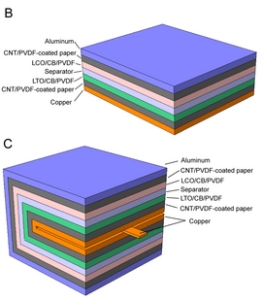A combination of nanotechnology and the traditional art of paper folding, known as origami, could be a key to a significant step toward improved battery technologies.
 The above image illustrates the architecture of a foldable lithium-ion battery ASU engineers have constructed using paper coated with carbon nanotubes.
The above image illustrates the architecture of a foldable lithium-ion battery ASU engineers have constructed using paper coated with carbon nanotubes.
Arizona State University engineers have constructed a lithium-ion battery using paper coated with carbon nanotubes that provide electrical conductivity.
Using an origami-folding pattern similar to how maps are folded, they folded the paper into a stack of 25 layers, producing a compact, flexible battery that provides significant energy density – or the amount of energy stored in a given system or space per unit of volume of mass.
Their research paper in the journal Nano Letters has drawn attention from websites that focus on news of technological breakthroughs.
The researchers have also developed a new process to incorporate a polymer binder onto the carbon nanotube-coated paper. The polymer binder improves adhesion of the structure’s active materials.
The achievements open up possibilities of using the origami technique to create new forms of paper-based energy storage devices, including batteries, light-emitting diodes, circuits and transistors, says Candace Chan, who led the research team.
Chan is an assistant professor of materials science and engineering in the School for Engineering of Matter, Energy and Transport, one of ASU’s Ira A. Fulton Schools of Engineering.
Fellow ASU engineering faculty members, associate professor Hanqing Jiang and assistant professor Hongyu Yu, have played leading roles in the work.
Read more about the team's efforts at Nanowork.com, Phys.org and in Nature magazine online.